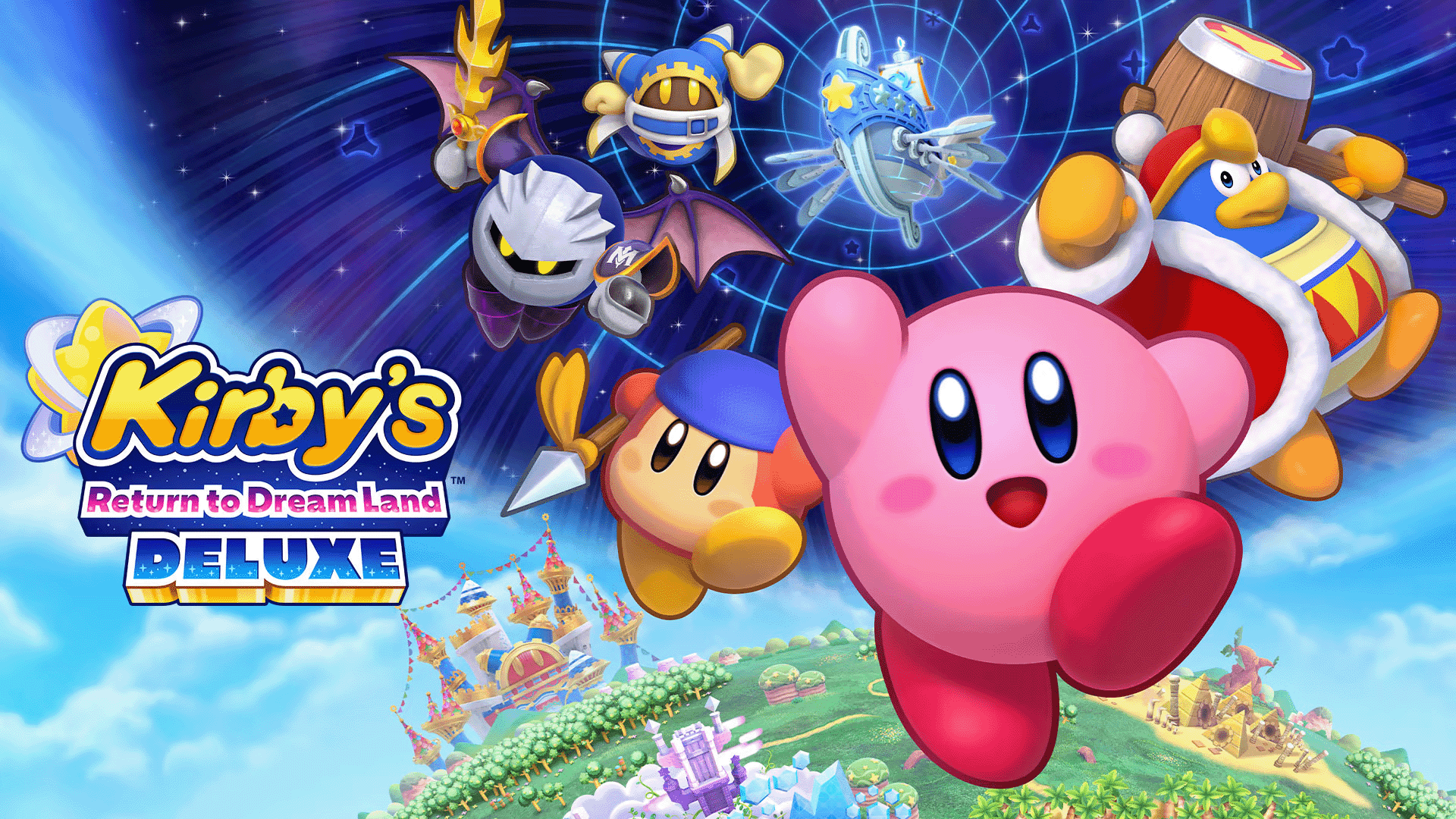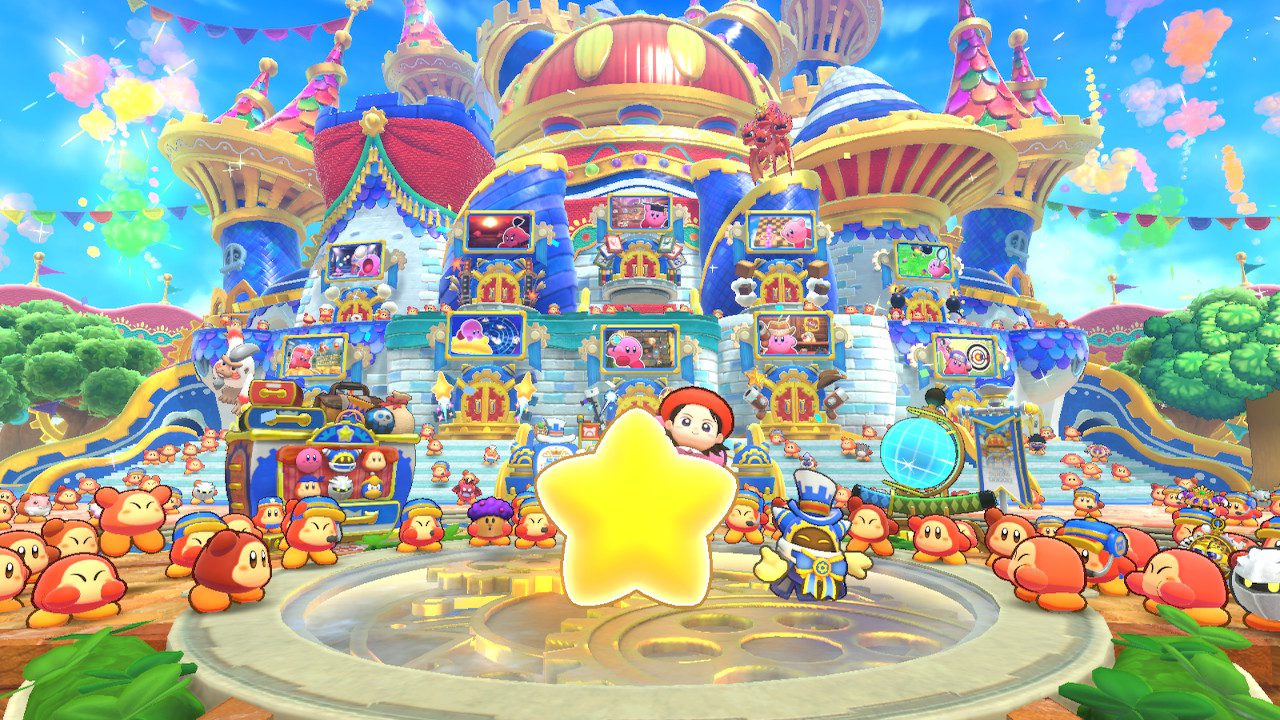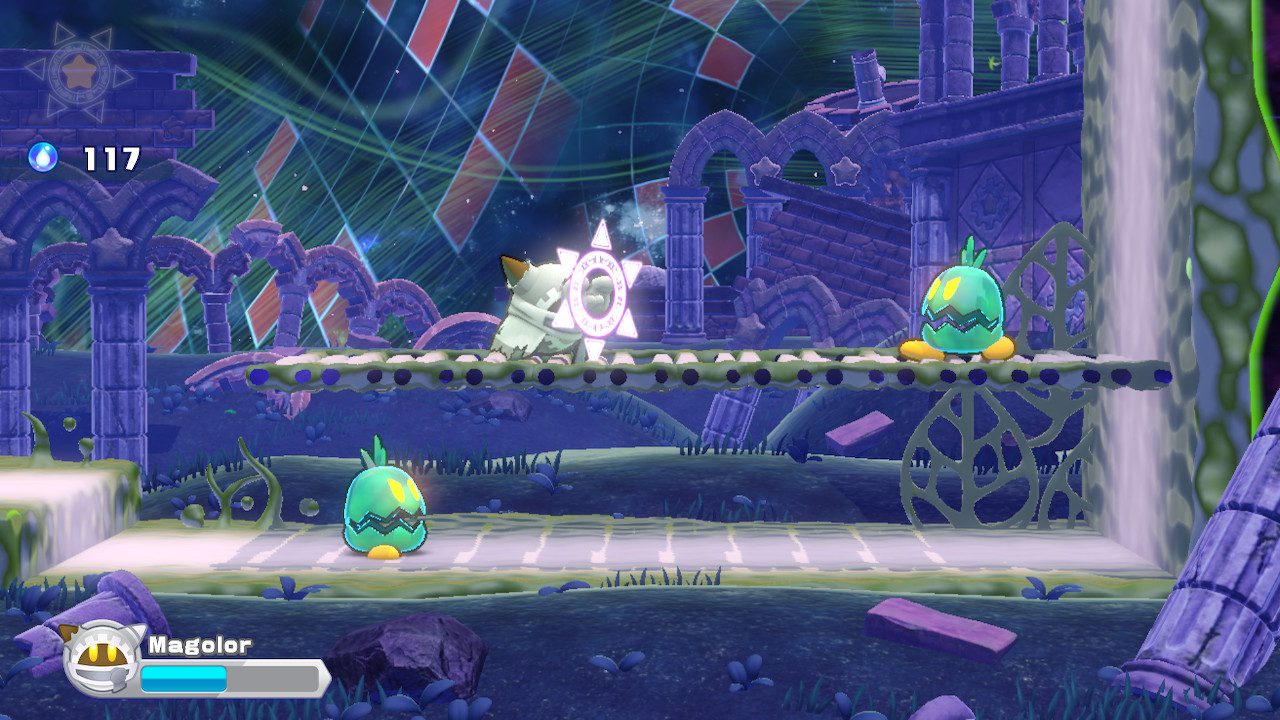
Disclaimer: Writer is an investor in Nintendo.
Many years ago, when long division was my greatest enemy and the Wii was still Nintendo’s hottest console, I received a game known in the west as Kirby’s Return to Dream Land… and I enjoyed the heck out of it. My brother and I guided this little pink sphere and cool sword guy through an adventure that culminated in an ending we never saw coming with a challenge that our young selves were just barely able to overcome. I still remember my Mom keeping the box propped up in the kitchen as she made a Kirby cake for our birthday, per our request.
…If you can’t tell, I have a lot of attachment to this game. It’s no surprise that I was excited to hear it was being remastered for the Nintendo Switch, with new content in the form of minigames and an epilogue. However, it is just a remaster, meaning the original content remains largely unchanged. So, is this worth it for your wallet – and good for your soul? Let’s find out.
Story/Setting
The adventure begins, if you can believe it, on a sunny day in Dreamland. Kirby’s running from King Dedede with cake in hand when an interdimensional spaceship suddenly comes crashing down. Inside the wreckage lies a mage known as Magolor, and Kirby generously offers to recover his ship’s lost parts. So, yeah, nothing too deep here, but Magolor is certainly an interesting character. Where did he come from? Why does he travel between dimensions? Some questions will be answered by the end, but others we are left wondering.
What’s less interesting than Magolor is the environments you travel through. There’s the occasional cool level, but for the most part you’ll be running through a grassland, desert, ocean etc. etc. Sure, it’s all quite easy to digest, but you won’t be thinking too hard about the world like I was when playing Kirby and The Forgotten Land.
Main Gameplay
Let’s move on to what’s most important in Kirby titles: the gameplay, and, specifically, the variety. The games in this series are notoriously easy, but it’s by design. From the start Kirby was intended to be an introduction to gaming (watch the series creator Masahiro Sakurai’s video on the concept). He has the ability to inhale enemies, fly, and starting in the second game, copy their abilities. What this means is that you’ll rarely find yourself in tight platforming situations, so enemies and combat take center stage. In Kirby’s Return to Dream Land Deluxe, there are a total of 26 copy abilities, 2 of which are completely new. Every single one of these abilities gives you a new moveset, some of which have literally a dozen different actions. There’s also 5 super copy abilities that show up in a few levels and allow you to wreak absolute havoc. None of them are too in-depth, but how could you say no to Snow Bowl Kirby? Look at those eyes!
You can press B or shake the controller like the good ol’ days.
These really help spice up the gameplay, which is needed because the main campaign is extremely easy. I hardly ever died, even when I was playing pretty recklessly. Kirby has a decent amount of health, and you’ll find plenty of food that allows you to regenerate it anyway. I’d really only say things get moderately tough towards the last couple of levels, and the final boss poses a decent challenge. Fortunately, you do unlock an ‘Extra Mode’ after beating the campaign which is really the whole game over again, but with tougher enemies, badder bosses, and way fewer recovery items all with half the health bar. It’s still nothing absurdly difficult, but if you’re unlike me and haven’t played through this game several times, I think you’ll find a decent challenge. I sort of wish you could just select this mode from the get-go though.
Even if you don’t feel like playing the whole game over again and want to stick to a single playthrough, when you’re constantly switching between different abilities and testing out all their moves, it’s tough to get bored. You might not always be having the time of your life, but things never felt stale. Plus, there’s collectible ‘energy spheres’ in every level that force you to keep your eyes peeled if you want to unlock every challenge and copy ability room back at Magalor’s ship.
Side Modes

You earn dress-up masks by completing stamp rallies in Merry Magoland.
There’s even more good news for you one-and-done sort of folk, because this remaster added two whole new modes: Merry Magoland and the Magolor Epilogue. Yes, quite a lot of focus on Magolor, but I’m fine with someone else taking the spotlight (just only for a bit.) Merry Magoland is essentially a collection of different subgames from throughout the series, with the addition of some new ones. Classics returning include Samurai Kirby, Bomb Rally, Checkerboard Chase and more.
If I had to give one complaint, it’s the removal of Scope Shot that was in the original Return to Dream Land. I’m not sure why it wouldn’t work fine on the Switch – it did involve motion aiming, but you could use the gyro in joycons for that, or stick controls. The best explanation I’ve heard is that it was a cooperative game mode rather than a competitive one, so it wouldn’t fit with the others in Merry Magoland… but they could have just made a separate mode or stuck it somewhere in the ship like it was originally.
Oh well. Merry Magoland is still fun, and holds 120 challenges for you to do as a single player that will earn you reserve items (such as a copy ability or food) that can be used in the main adventure to make it yet even easier.
Concerning the Magolor Epilogue, I’m pretty satisfied with what was done here. It’s unlocked after beating the main story, and follows the mage as he travels through another dimension attempting to regain his lost power. There’s over 30 short levels to run through, which include some boss fights. They all pull from the main game, of course, but with new visuals, awesome remixed music, plus new challenges and puzzles.

You’ll start out weak, but finish up strong.
To make this stand out from the main campaign, Magolor has been given a large set of unlockable abilities that can be upgraded with magic points. I don’t want to spoil them all for you, but be prepared to vanish into thin air, fire a giant laser beam, and rain down bombs from above. Many of these moves are also designed to hit enemies multiple times, helping you increase a combo counter that rewards more magic points the longer you keep it up. I found this to be fun, yet stressful at times. You’ll still be rewarded magic points from defeated enemies and puzzles anyways, so don’t feel like you have to constantly be on your A-game just to keep up.
Graphics
Time to finally take a break from the gameplay to talk quickly about the graphics. Perhaps the most polarizing bit of this remaster is the addition of cartoon outlines on all the characters and enemies. I can’t deny that the decision is a bit questionable, and part of me wonders if it was just done to make the game look more different from the Wii version. Nevertheless, I found it perfectly fine as I played through the game, but it still would have been nice to have the option to turn it off. Concerning everything else, all the environments, menus, and minigames look great, and run at a smooth 60 fps… except for Merry Magoland, which is understandably capped at 30. The Switch just isn’t very capable of running high-definition, crowded 3D environments. Still, it’s a bit disappointing seeing the cute waddle dees robbed of their animation frames as you move further away.
From a faith perspective
You may be thinking that there’s no way you can possibly relate the faith to Kirby, but you’d be wrong as the creator of the universe is inherently tied to everything in it. Also, this is Catholic Game Reviews.
Perhaps the most impressive thing about the pink ball of power is his ability to encounter great evil without it affecting him negatively one bit. We’ve all experienced the effects that other’s sin has had on us – whether it’s some annoying person on Twitter getting you worked up, or a friend being a bad influence, it’s surprisingly easy to adopt the vices of others, yet often difficult to imitate the virtues of those around us. Not with Kirby, though. This little guy gets himself into the most dire of situations, including in this game, but he acts just the same as he does at the beginning of the adventure at the very end. Yet it goes further than this.
Kirby’s copy ability is like a complete cleansing of malice. When he inhales an enemy, he obtains their helpful powers without any of their evil. He may don a new hat and sword, but it doesn’t seem to make him any less himself. It’s genuinely a useful analogy for what we are tasked to do when interacting with the world – find what is good, and separate it from the bad. I only wish I was as good at it as Kirby.
“Finally, brethren, whatever is true, whatever is honorable, whatever is just, whatever is pure, whatever is lovely, whatever is gracious, if there is any excellence, if there is anything worthy of praise, think about these things.” (Phillipians 4:8, RSVCE)
Conclusion
Kirby’s Return to Dream Land Deluxe is a solid game to be sure. It ain’t a groundbreaking title, but consistently fun throughout, and I found the additional content to be satisfactory. I’d say it certainly stands above Kirby Star Allies. This is not a very hard game outside of post-game content, and those who are only planning to do a casual run-through of the campaign and prologue with some subgames on the side should probably only expect 10-15 hours of entertainment. However, I found it plenty fun to go for the 100%, and got in 30 or so hours doing it.
There are perhaps more morality/parental warnings than you might expect for such a cute series, and I’ve listed them all down below.
Scoring: 87%
Gameplay: 4.5/5
Graphics: 4.5/5
Music: 4/5
Morality/Parental Warnings
Magic/Occult: Magolor is a mage, and in his epilogue especially you’ll be doing things like conjuring magic spells while collecting gem apple fragments for an ethereal altar. Additionally, one of the final boss fights in extra mode has you fighting a soul of a character that is possessed by a mysterious crown. Finally, when speaking to Magolor on his ship, he might mention that their meeting seems like fate and that “it must be the work of divine destiny.”
Violence: Kirby and most enemies will fight with swords, bombs, and sometimes toy-like guns. It’s pretty slapstick violence, although some of the boss fights can get quite scary for younger folk, especially towards the end. There’s never any blood of course, but Kirby very well might get giant-laser-beamed… yet stay peppy through it all.
Online connectivity: Samurai Kirby 100 pits you against 99 other players, showing you their potentially inappropriate usernames. As always this can be disabled with Nintendo Switch parental controls.
